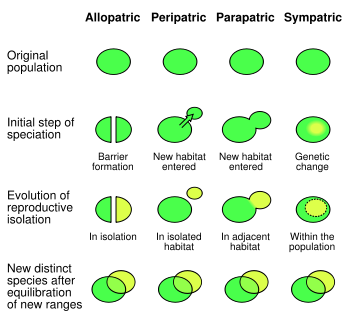Peripatric speciation
Jump to navigation
Jump to search

Peripatric speciation is a form of speciation, the formation of new species through evolution. In this form, new species are formed in isolated peripheral populations; this is similar to allopatric speciation in that populations are isolated and prevented from exchanging genes. However, peripatric speciation, unlike allopatric speciation, proposes that one of the populations is much smaller than the other.
Peripatric speciation was originally proposed by Ernst Mayr, and is related to the founder effect, because small living populations may undergo selection bottlenecks.[1] Genetic drift is often proposed to play a significant role in peripatric speciation.[2]
See also
References
- ↑ Provine WB (2004). "Ernst Mayr: Genetics and speciation". Genetics. 167 (3): 1041–6. PMID 15280221.
- ↑ Templeton AR (1980). "The theory of speciation via the founder principle". Genetics. 94 (4): 1011–38. PMID 6777243.